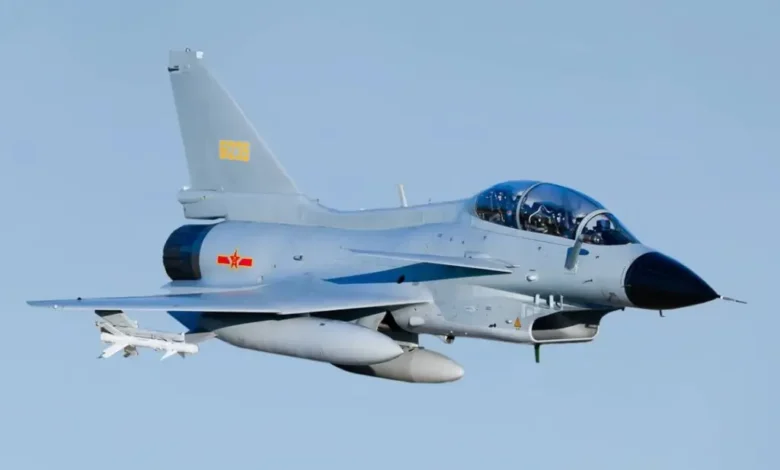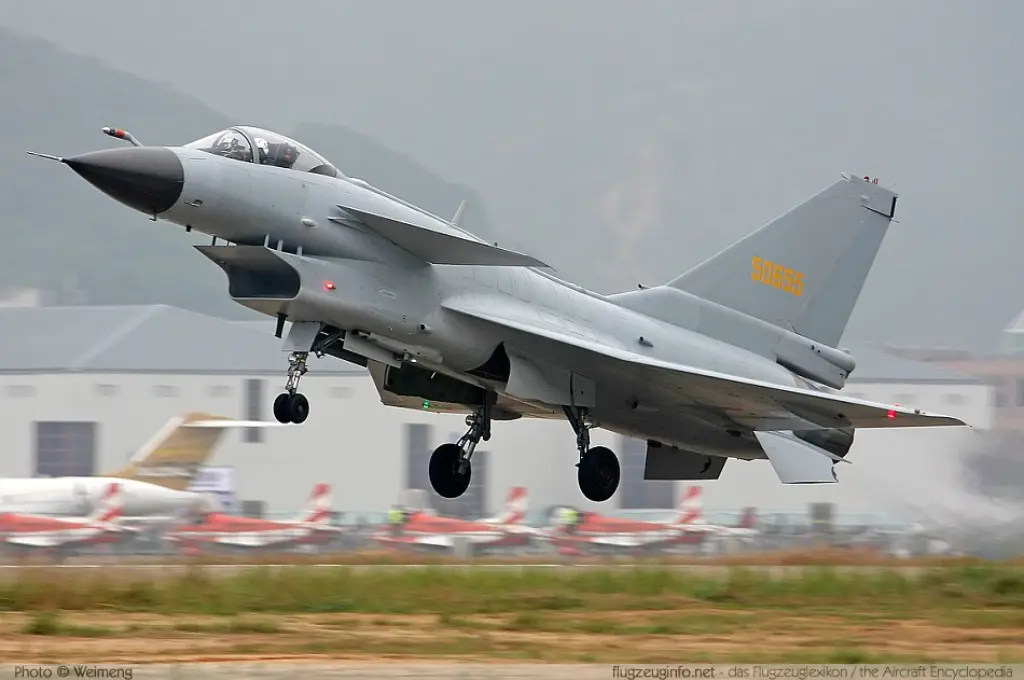Chengdu J-10

The Chengdu J-10, also known as “Vigorous Dragon,” is a multirole fighter aircraft developed by Chengdu Aircraft Corporation for the People’s Liberation Army Air Force (PLAAF). First flown in 1998 and introduced in 2005, the J-10 is designed for air superiority and ground attack missions. It is China’s first domestically developed fourth-generation fighter and has been continuously upgraded with advanced avionics and weapon systems.
Fact Sheet
| Role | Multirole fighter |
|---|---|
| Manufacturer | Chengdu Aircraft Corporation |
| First Flight | 1998 |
| Service Entry | 2005 |
| Crew | 1 (J-10A/C) or 2 (J-10S) |
Specifications
| Length | 16.9 m (55.4 ft) |
|---|---|
| Wingspan | 9.75 m (32 ft) |
| Height | 5.43 m (17.8 ft) |
| Empty Weight | 9,750 kg (21,495 lb) |
| Max Takeoff Weight | 19,277 kg (42,500 lb) |
| Powerplant | 1 × WS-10B or AL-31FN turbofan |
| Thrust | 27,557 lbf (122.6 kN) with afterburner |
| Max Speed | Mach 2.0 (2,470 km/h; 1,535 mph) |
| Service Ceiling | 18,000 m (59,055 ft) |
| Range | 1,240 mi (2,000 km) combat radius |
| Rate of Climb | ~60,000 ft/min (305 m/s) |
Avionics & Armament
| Main Radar | KLJ-7A AESA radar |
|---|---|
| Avionics | Advanced avionics suite, electronic warfare systems |
| Armament | One 23-mm cannon; Up to 11 external hardpoints for: – Air-to-air missiles (PL-8, PL-10, PL-15) – Air-to-ground munitions (bombs, rockets) – Precision-guided bombs – External fuel tanks |
Notable Features
- Multirole capability for air-to-air and air-to-ground missions.
- Advanced avionics for superior situational awareness.
- High maneuverability for dogfighting superiority.
- Continuous upgrades to enhance combat capabilities.
- Widely exported to allied nations, including Pakistan (JF-17 derivative).

The Chengdu J-10 (Chinese: 歼-10; pinyin: Jiān-10; NATO reporting name: Firebird, though sometimes referred to as “Vigorous Dragon”) is a Chinese medium-weight, single-engine, multi-role combat aircraft. It’s a significant milestone for China’s indigenous aerospace industry, representing a substantial leap forward in capability compared to earlier Chinese fighter designs. The J-10 incorporates a distinctive delta wing and canard configuration, a design choice that gives it excellent agility.
Development and Purpose
The J-10’s development began in the mid-1980s, driven by China’s need for a modern, indigenous fighter that could compete with contemporary Western and Soviet fourth-generation aircraft (like the F-16 and MiG-29). The project faced significant challenges, particularly with engine development, leading to reliance on Russian engines for early production models.
The first prototype of the J-10 made its maiden flight on March 23, 1998. It officially entered service with the People’s Liberation Army Air Force (PLAAF) in 2005, marking a new era for Chinese military aviation.
Key Design Features and Capabilities
The J-10 is a highly capable “4th generation” or “4.5th generation” fighter, depending on the variant and its specific upgrades.
- Canard-Delta Wing Configuration: This aerodynamic layout, similar to the Eurofighter Typhoon and Dassault Rafale, provides high maneuverability, particularly at low speeds and high angles of attack. The canards are close-coupled to the delta wing, generating significant lift and improving pitch control.
- Digital Fly-by-Wire (FBW) System: An essential feature for controlling an inherently unstable design, the J-10’s FBW system allows for precise and agile flight, reducing pilot workload.
- Single Engine: The J-10 is powered by a single turbofan engine. Early variants (J-10A/B) primarily used the Russian Saturn AL-31FN (a variant of the AL-31 used in Su-27/30). Later and more advanced variants, particularly the J-10C, are increasingly powered by the indigenous Shenyang WS-10B “Taihang” turbofan, marking a crucial step towards China’s self-sufficiency in high-performance aero-engines. Some WS-10 variants have demonstrated thrust-vectoring capabilities.
- Advanced Avionics and Cockpit:
- “Glass Cockpit”: Features multiple large liquid crystal multi-function displays (MFDs) and a Head-Up Display (HUD).
- Helmet-Mounted Sight (HMS): Allows the pilot to cue weapons by simply looking at a target.
- Radar: Early J-10A variants used a Type 1473H pulse-Doppler radar. The J-10B introduced a Passive Electronically Scanned Array (PESA) radar. Most notably, the J-10C is equipped with an indigenous Active Electronically Scanned Array (AESA) radar, which provides superior detection range, multi-target tracking, and resistance to jamming.
- Electronic Warfare (EW) Suite: Includes integrated electronic countermeasures (ECM) and radar warning receiver (RWR) systems for self-protection.
- Multirole Capability: Designed for both air-to-air combat and air-to-surface strike missions.
- Weaponry and Hardpoints: The J-10 has 11 hardpoints (6 under-wing, 2 under-intake, and 3 under-fuselage) capable of carrying up to 5,600 kg (12,300 lbs) of ordnance and external fuel tanks. Its typical armament includes:
- Air-to-Air Missiles: PL-8 (short-range IIR), PL-10 (advanced short-range IIR for J-10C), PL-12 (medium-range active radar-guided), and the potent PL-15 (long-range active radar-guided for J-10C), which features a dual-pulse rocket motor for extended range.
- Air-to-Surface Missiles: KD-88 standoff land-attack missile, YJ-91 anti-radiation missile.
- Precision-Guided Munitions (PGM): Laser-guided bombs (LS-500J, LT-2), glide bombs (LS-6, GB series), satellite-guided bombs (FT-1).
- Internal Cannon: A 23mm Gryazev-Shipunov GSh-23 internal cannon.
- External Pods: Can carry targeting pods (e.g., K/JDC01A, CM-802AKG), IRST pods, and ECM pods.
Key Variants
- J-10A (Vigorous Dragon): The initial single-seat production variant. The export designation is F-10A or FC-20.
- J-10S: A tandem two-seat combat-capable trainer variant.
- J-10B: An upgraded single-seat variant, featuring a redesigned nose with a fixed Diverterless Supersonic Inlet (DSI) which reduces radar cross-section and improves supersonic performance. It also incorporated a PESA radar and an IRST sensor.
- J-10C: The latest and most advanced production variant. It incorporates an AESA radar, significantly upgraded avionics, an enhanced electronic warfare suite, and is increasingly powered by the indigenous WS-10B engine. The J-10C also has a reduced radar cross-section due to design refinements and stealth coatings.
- J-10CE: The export version of the J-10C.
Operators and Combat History
- China (People’s Liberation Army Air Force – PLAAF and People’s Liberation Army Naval Air Force – PLANAF): The primary and largest operator, forming a significant backbone of China’s fighter fleet, particularly the advanced J-10C variant.
- Pakistan (Pakistan Air Force – PAF): Became the first export customer for the J-10CE, with deliveries beginning in 2022. Pakistan acquired these jets to modernize its air force and potentially to counter the Indian Air Force’s Rafale fighters.
Combat History: Until very recently, the J-10’s combat effectiveness in real-world engagements was largely unproven, with its capabilities primarily demonstrated in exercises and simulated combat. However, reports emerging in May 2025, during an alleged India-Pakistan conflict, claimed that Pakistan Air Force J-10CEs engaged Indian Air Force aircraft and achieved air-to-air victories.
These claims, while largely unconfirmed by independent sources and subject to ongoing debate and counter-claims from both sides, if proven accurate, would represent the J-10’s first confirmed air-to-air kills in combat and a significant validation of its capabilities, particularly with the PL-15 missile.
The Chengdu J-10 signifies China’s burgeoning capabilities in advanced aircraft design and manufacturing. With its continuous upgrades, particularly the J-10C’s AESA radar and indigenous engine, and its increasing export success, the “Vigorous Dragon” is a significant player in the global fighter market and a key component of China’s expanding air power.



